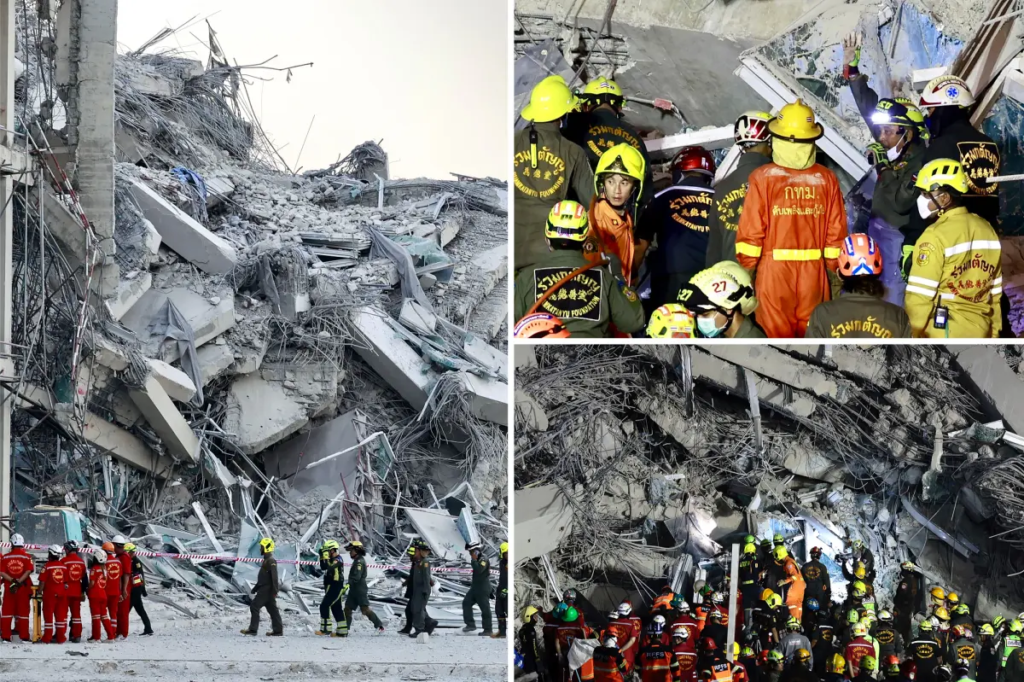More than four days have passed since a catastrophic 7.7-magnitude earthquake struck Myanmar, sending tremors across the region, toppling buildings as far as Bangkok, and shaking neighboring provinces in China. Rescue teams continue their desperate efforts to locate survivors, but as time elapses, optimism dwindles.
The critical first 72 hours often termed the “golden” window for saving lives have now elapsed, significantly reducing the chances of survival for those trapped beneath the wreckage without access to water.
Authorities confirm that over 2,700 people have perished in Myanmar due to what is now recorded as the most powerful earthquake to hit the conflict-ridden nation in over a century. However, experts caution that the actual death toll could take weeks to fully assess.
A Nation in Mourning
The disaster has yielded harrowing tales of survival alongside accounts of immense tragedy. Bridges and buildings collapsed, including structures in Bangkok, where emergency workers continue efforts to extricate individuals trapped beneath a partially built high-rise.
The quake’s epicenter was identified in Myanmar’s central Sagaing region, near Mandalay, a historic city of 1.5 million inhabitants known for its ancient temples and royal palaces. The area has been largely isolated due to the collapse of a crucial bridge spanning the Irrawaddy River.
For the first time in years, Myanmar’s ruling military junta has extended a rare request for international aid. The United States has dispatched a team following an official plea from the junta, with additional assistance arriving from China, Russia, and multiple other nations.
This earthquake stands as Myanmar’s deadliest natural disaster in recent history, striking amid a prolonged civil war that has already left infrastructure in disrepair, communication lines severed, and millions without adequate resources for sustenance and shelter.
On Tuesday, at precisely 12:51 p.m. local time the moment the earthquake struck four days earlier the nation observed a solemn minute of silence in remembrance of the fallen.

A Staggering Human Toll
According to Myanmar’s military government, the disaster has claimed at least 2,719 lives, with an additional 4,521 individuals injured and 441 reported missing. General Min Aung Hlaing stated grimly that the likelihood of survival for those still unaccounted for is “extremely slim.”
The United States Geological Survey (USGS) has projected that the final death toll could exceed 10,000 based on early modeling.
Even in Bangkok situated hundreds of miles from the epicenter at least 20 people lost their lives. Thirteen of these casualties resulted from the sudden collapse of an under-construction building, leaving numerous individuals buried beneath the rubble. As of Tuesday morning, grieving families continued to gather at the site, clinging to the faint hope of miraculous rescues.
This earthquake is the most severe to strike Myanmar since a 7.9-magnitude quake shook Taunggyi in 1912. Additional fatalities have been reported in the capital, and aftershocks including a 6.7-magnitude tremor persisted throughout the weekend.
In response, the military junta has designated March 31 to April 6 as a period of national mourning, during which flags will be flown at half-staff.
Unparalleled Devastation
The level of destruction across the nation is unparalleled in over a century, according to the International Federation of Red Cross and Red Crescent Societies (IFRC). IFRC’s Myanmar program coordinator, Marie Manrique, emphasized the urgency of the situation, warning that the remaining window for rescuing those trapped is rapidly closing.
Amid the widespread devastation, stories of survival have surfaced. Footage obtained by CNN captures two teenage girls and their grandmother confined within a small air pocket beneath their collapsed home, frantically pounding against concrete with a butter knife. After a harrowing 15-hour ordeal, they were finally freed.
Two women, whose hotel in Mandalay crumbled around them, described the terror of being buried under debris. “We were engulfed in darkness,” one survivor recounted. “Thankfully, we had a phone to provide light. Without it, we might not have survived. We used it to clear rubble from on top of each other.”
Yet, alongside such remarkable rescues are heartbreaking accounts of loss. In Mandalay, a staggering 160 monks perished inside a collapsed examination hall, with an additional 85 sustaining injuries. Many were crushed as they attempted to flee through the single exit when the structure gave way.
Elsewhere, the quake shattered mosques filled with worshippers attending Friday prayers. Communication disruptions continue to hinder the assessment of damage, leaving many areas still unaccounted for.
In Shan state, an affected father described the moment of disaster: “Children and the elderly collapsed from dizziness. The tremors were overwhelming. We were in shock. Children screamed in terror. We urgently need food and water.”
Entire communities remain displaced, forced to spend nights in the open air due to the destruction of their homes or fear of further quakes. Hospitals, schools, and historic landmarks have suffered significant damage, while a crucial bridge over the Irrawaddy River has collapsed entirely.
Global Aid Efforts and Challenges

Despite Myanmar’s historical reluctance to accept international aid, the military leadership has now appealed for assistance. China was the first to respond, dispatching a relief team and pledging $13.8 million in humanitarian aid. Russia followed suit, deploying specialists, rescue dogs, and medical personnel.
The UK, Ireland, and Australia collectively announced over $20 million in aid packages. US President Donald Trump labeled the disaster “horrific” and confirmed that American relief efforts were en route. The United Nations has allocated an immediate $5 million emergency fund for Myanmar and is mobilizing additional teams.
However, relief efforts face severe challenges. Myanmar’s civil war had already devastated infrastructure, and the earthquake has only compounded the situation. Many of the hardest-hit regions are contested territories, where both the military and rebel factions operate independently, complicating the delivery of aid.
The UN warns that obstructed roads, collapsed structures, and widespread power outages are hampering relief operations. Medical teams report shortages of critical supplies, including trauma kits and anesthetics, while field hospitals struggle to manage the influx of casualties.
The IFRC has launched an emergency appeal for $113 million to support relief efforts over the next two years. “The need for support is urgent,” stressed Alexander Matheou, IFRC’s Asia-Pacific regional director. “This isn’t merely a disaster it is a humanitarian catastrophe layered upon existing crises.”
Why Was This Earthquake So Catastrophic?

While Myanmar sits on a seismically active fault line, most quakes occur in remote areas. This disaster, however, struck major population centers, exacerbating destruction and loss of life.
The USGS determined that the earthquake was shallow, originating only 10 kilometers below the surface. Shallow quakes tend to inflict the most severe damage. Scientists calculated that the energy released by the quake was equivalent to 334 atomic bombs.
The quake originated along the Sagaing Fault, a north-south fault line running through Myanmar, where tectonic plates shifted in a “strike-slip” motion meaning they moved horizontally against each other.
British Geological Survey seismologist Brian Baptie noted that in some areas, the ground shifted by up to five meters within the span of a single minute. Buildings constructed from timber and unreinforced masonry crumbled instantly, leaving devastation in their wake.
With aftershocks expected to persist for months, the full extent of Myanmar’s tragedy is still unfolding.






0 Comments